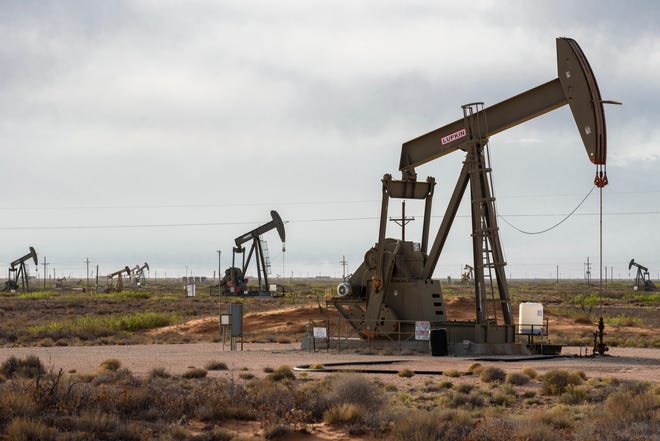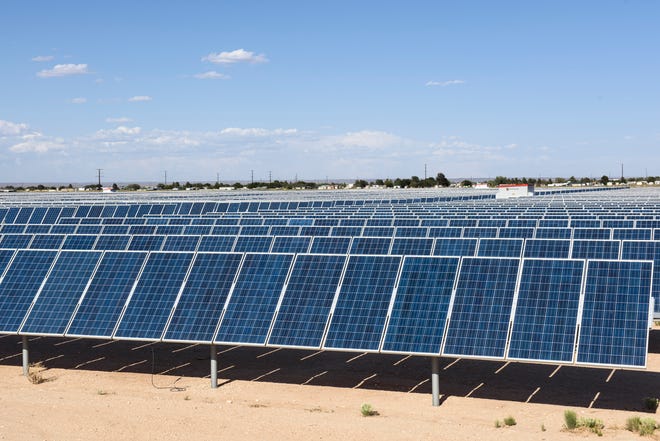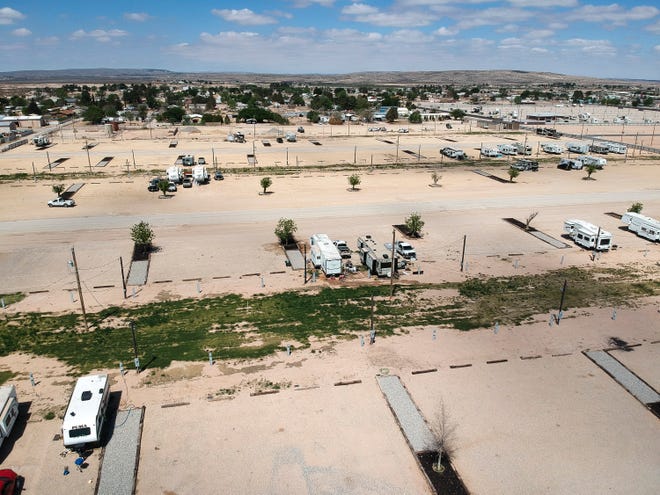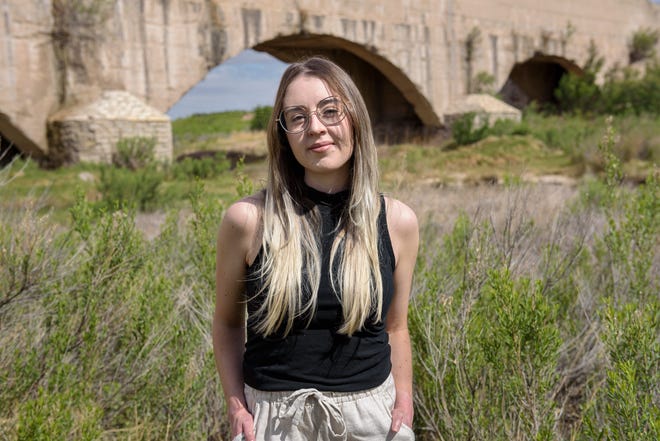J. Weston Phippen

CARLSBAD, N.M. — The blue van turned onto the pitted road, and for miles the tallest objects on the horizon were the brush and yucca. Soon, signs appeared with arrows that pointed to dirt trails with curious names like “Illinois Camp Booster.” Suddenly, what looked like a hidden city appeared and the landscape was filled with warehouses, tall cylindrical gas storage tanks and, as far as the eye could see, rusted, bobbing oil pump jacks.
Inside the van were three members of Citizens Caring for the Future (CCFF), practically the lone organized resistance to the oil and gas industry in Southeastern New Mexico. They were an odd bunch. At the wheel was Nick King, a Mennonite pastor and owner of a small solar company. Behind him was Joan Brown, a Catholic Franciscan nun with a grandmother’s delicate voice. And aiming a camera out the passenger window was Nathalie Eddy, a field organizer with Earthworks, a national environmental nonprofit, who’d driven from Colorado for the day’s excursion.
“This is what it’s like, 24/7,” Eddy said, pointing at the busy landscape, the trucks entering and leaving and the arms of the pumpjacks rotating.
The Permian Basin stretches from Carlsbad, New Mexico, 30 miles across the Texas border. It is 75,000 square miles of metal and tubes and spire-like pipes burning gas, all above jackrabbit scrubland. Depending on your feelings about the industry, the Permian Basin is either awe-striking or nauseating.
Post-COVID-19 growth:Midland oil and gas operator builds Permian Basin assets
An inescapable fact is that it stinks. A hard-to-place mixture of rotten eggs and the oily undercarriage of a car wafted in the wind, and it was the source of this smell — gas leaks — that Eddy’s $70,000 camera and its special lens were designed to find. “Oh my gosh,” Brown said at one point, begging the others to close their windows. “It’s really bad here. Oh my gosh.”
The crew’s first stop was a place that Eddy had visited at least 10 times before. Instantly, her camera lit up with a rainbow of colors — gas leaks from what seemed to be a corroded pipe. “I’ve stopped filing complaints here,” she said, “because at some point it becomes redundant.”
With Eddy’s help, the group has already filed 130 complaints with the New Mexico Environmental Department. The task is left to them, in part, because of the insular and overwhelmingly pro-industry politics in the region, and because state regulators are stretched thin. But they’ve also taken on the work because, while oil and gas has brought untold wealth, jobs and tax money, they want to expose the hidden toll that comes with living beside one of the world’s largest oil fields.

COVID-19 pandemic shuttered trade, tourism
Last year, as the pandemic shuttered trade and brought travel to a standstill, oil prices went negative for the first time in history. By June, the lost revenue threatened to cost the state billions, prompting legislators to cut spending and tap into the government’s financial reserves. And so began an internal debate that’s repeated every time the pumpjacks slow: Is it time, finally, for New Mexico to disentangle itself from near total reliance on a single industry?
In its 2020 annual report, the New Mexico Oil and Gas Association credited the industry with bringing $2.8 billion to state coffers — totaling 0ne-third of New Mexico’s annual budget. “And that percent is just from royalties,” noted Eddy County Commissioner Ernie Carlson, a former industry accountant who wears a stockman’s brimmed cowboy hat and speaks in a matter-of-fact rural tone. “There are a lot of other industries tied to oil and gas, and if you measure that it’s about 45 percent of the state’s budget.”
Carlson and other industry proponents argue that without oil and gas, New Mexico’s economy would dry up and blow away. They point to the fact that the industry in 2019 underwrote $1.36 billion of the state’s education costs, and are quick to suggest what might happen if regulation ever got the upper hand.
News:New Mexico activists call on EPA for stricter oil and gas emission limits
As a recent ad from the New Mexico Oil and Gas Association warned voters, “Our kids have had to overcome a lot this year, but now they’re facing yet another challenge — the New Mexico legislature. Proposed laws aimed at oil and gas would take billions away from public education, gutting our schools. Reading programs, sports, even school lunches – all at risk.”
These same figures are cited by environmentalists and energy economists as evidence that New Mexico is long overdue for a weaning. They argue that the state needs to diversify its economy.
And what better way to do it than with renewable energy, like solar and wind?
“Just from wind, the energy potential is 20 times what the state consumes,” said Doug Howe, a board member of the New Mexico Renewable Energy Transmission Authority. “To really monetize that as an economic driver, we have to turn to thinking of exporting all that energy to nearby states.”

New Mexico is already in a renewables race with Wyoming to build a clean-energy transmission line across the Southwest. Whoever wins that contest will become one of the largest clean-power exporters in the West. The prize is potentially so huge that a host of environmentalists, government progressives and even renewable industry proponents have joined forces, urging New Mexico to remove its eggs from the oil basket and transfer them as quickly as possible into wind and solar.
So it came as a surprise to many back in March when the state’s Democratic governor sought to reverse President Joseph Biden’s 60-day moratorium on new federal oil and gas leases.
Biden’s moratorium so riled Gov. Michele Lujan Grisham that she sent a letter to the president, asking him to change his decision and let the oil flow. While on the Texas side of the Permian Basin much of the land is private, more than half of New Mexico’s wells are on federal land. As she wrote in her letter, “Oil and gas production remains a significant economic force in New Mexico.”
Was this the same governor who in her first month in office signed an executive order to create a climate strategy, one that would hold the industry accountable?
New Mexico reflects on past, looks at possible future
Energy leaders believe New Mexico faces two opposing futures: Act swiftly and become the leader of green energy, or stick with oil and gas as the rest of the nation pivots. Whichever path the state takes will be particularly consequential for Carlsbad. Not only is it rich in oil and gas, but because of the ample wind and sun in Southern New Mexico it also stands to be at the epicenter of the state’s renewable-energy revolution.
Before they’d set out in the van, a few CCFF members had gathered at King’s house to discuss this future, mostly by reflecting on the past.

“When I came here in 1986, it was a very different community,” said Gene Harbaugh, leaning back in his chair and thumbing thick blue suspenders. Now 85, the retired Presbyterian minister is one of the original founders of CCFF. Like other core members, he brings a religious mindset to the group’s mission of conservation in the Permian Basin. Like many of them, he now finds himself a pariah in a place where he was once an influential leader.
“It was a very civically active town,” Harbaugh said, recalling a time when he oversaw a church of 300 souls. The mayor prayed with his congregation, and each year the community gathered on Thanksgiving to eat pies.
“Gradually, things began to turn, and part of it was really a concern to try and develop the area economically,” he said. “But Carlsbad turned to the sort of industries that were really, to me at least, dead ends.”
Outlawed:Oil and gas spills now illegal in New Mexico. Industry supports rule change
By that “sort of industry,” Harbaugh was referring to fracking — the technology of horizontal drilling in which wells once unreachable began yielding black gold. For Carlsbad, it meant a boom unlike any other. Lines of tanker trucks travel U.S. Route 285 through town, stretching from the new Lowe’s at the north end to the southside IHOP. Accidents increased 70 percent, giving 285 the nomer “the highway of death.” Local hotels, which now charge upwards of $419 a night, filled with transient oil workers. Crime increased. And at any RV park, it wasn’t unusual to find cops and teachers hanging laundry from lines because their salary couldn’t afford them a house.
When Kayley Shoup returned to Carlsbad three years ago after graduating college, she was shocked by how much had changed. Two of her high school friends had just been diagnosed with rare cancers, and though she recognized that there was no clear case of cause and effect, the coincidence was enough to get her involved. She joined CCFF and, at 28, is the group’s youngest member.
Shoup worries about methane, a greenhouse gas that the Permian Basin releases more of than any other site in the nation, emitting one million tons per year, or the equivalent of 22 coal-fired power plants. This is especially problematic for the climate, given that methane is 25 times more potent at trapping heat in the atmosphere than carbon dioxide.

Drilling operations also release benzene, a carcinogen, and hydrogen sulfide, which is known to drop birds from trees and can, even in low concentrations, cause nausea, headaches and respiratory problems; long-term exposure is linked to neurological damage.
Residents near drilling sites have suffered mysterious nose bleeds. Rigs have exploded and showered noxious fracking chemicals onto people and their land. Southeastern New Mexico, and Eddy County in particular, has the worst rates of asthma in the state. And Eddy is one of only two rural counties in the country to make the list for worst air quality, a fact attributed to the oil and gas boom.
What Harbaugh finds most troubling is what he calls a psychic shift in the community. Carlsbad had always been a fairly poor area, with most jobs in mining or agriculture. So community institutions stepped up and people relied on one another, he said. And while he can’t totally blame the oil boom for the dwindling of his former congregation, Harbaugh said the industry, by nature, breeds a mentality of total self-reliance. Success is what can be pulled from the ground by one man or one company. “Individual freedoms are what now seem to be paramount,” Harbaugh lamented. “People are supposed to do whatever they want as long as it benefits them.”
And political leaders focus on profits over health, said Shoup. “For the government here it’s all about the economics.”
No long-term health studies have been conducted in Carlsbad, so CCFF is trying to commission its own study — though where they’d find the funds to do so is a big question. It’s a tall order for such a small group, and is yet another thing that has made the activists unpopular. Members say they are unwelcome at certain restaurants and given the cold shoulder in the grocery store.
“It has created a divide,” Shoup said. “I don’t usually tell lots of people my thoughts on the industry, because I’ll be shunned.”
Rising oil prices could bring more jobs, growth
When oil prices rise, so does the population of Carlsbad. More people means more jobs, which means more businesses and investment, which means more tax growth, which means streets get repaired and schools renovated, and finally there’s enough money to hire more police officers. Then there’s Carlsbad’s tangential oil and gas economy. The Blake’s Lotaburger is an endless line of new trucks paid for by oil money, packed with workers grabbing a quick meal. The grocery stores are filled with sunburned faces browsing the frozen meal sections.
The oil and gas industry employs some 134,000 workers in the state, and it’s not likely that any one industry will ever replace it. At the moment, wind and solar account for about 5,000 New Mexico jobs, and even the brightest projections allow for just 13,700 long-term renewable energy jobs in the next decade.

“Common business sense tells you that when you have a number one product as we do in oil and gas, that we ought to be studying how to enhance the industry so we can make more money,” said Eddy County Commissioner Carlson. “But what’s happening today is that every year we have to fight bills that would curtail the oil and gas industry. When those bills get introduced, even if they don’t pass, they send a message that this is not a favorable place for the industry to be.”
What often gets lost in all the arguments is that energy production is not a zero-sum game. As James Peach, a retired economy professor at New Mexico State University, points out, the rise of one industry — renewables or oil and gas — doesn’t necessarily diminish the other. The Permian Basin will yield more oil for a long time, possibly generations. Whether or not New Mexico decides to invest significantly in clean energy both to power the state and export to others should not be viewed as competition, but rather a separate opportunity; one that would surely serve New Mexico’s best interest.
Study:Fixing oil and gas methane emissions could create jobs in New Mexico, U.S.
“I looked this morning and the active rig count in the Permian is at 70, which was what it was before the moratorium,” Peach said, meaning that the federal pause on leases hadn’t affected the region at all.
But if the state fails to invest in wind and solar, the renewable-energy prize will go to Wyoming, leaving New Mexico with its decades-long single-minded reliance on oil and gas.
New Mexico faces uphill battle
To wean itself off oil and gas requires attracting other industries — an uphill battle for a state that lags behind in so many basic categories. “If we’re going to compete in this modern world, we need people to be able to work from anywhere,” Peach said, noting that New Mexico is one of the least wired states in the country. “We need to put more money into our state parks, the museums, the kinds of things that make this an attractive place to live.”
As the blue van jostled to a stop, the Mennonite pastor, the Catholic Franciscan nun, and the Colorado-based environmental activist stepped out and stared at a set of tanks in the near distance. Each was two stories tall. The stench of rotting eggs hung in the air.
Nathalie Eddy aimed her camera and, sure enough, the screen showed leaking gas.
The three climbed back into the van, silent as they drove away, surveying the vastness of the oil fields. But before they turned to go home, Eddy had one last place in mind, a site she’d visited two years earlier with New Mexico’s Commissioner of Public Lands, Stephanie Garcia Richard. Eddy was sure she could find it again, and as the van dipped into an arroyo she recalled to the other passengers about how Garcia Richards and her staff had gathered around the tank when a worker rushed over. He quickly climbed to the top, telling them that he just needed to “burp the cap.”
As he toyed with levers and pipes to relieve the pressure inside, oil began to gush. And as he frantically fumbled atop, more and more oil spilled onto the ground. Eddy remembered that Garcia Richard turned to walk away and yelled, “How do I shut that site down?”
Now, as the van pulled up, the site looked abandoned. Eddy seemed relieved. That is, until she pointed her camera at the tank.
“Look,” she said, motioning to the others toward her camera’s screen.
Dormant fumes were still escaping from the top, drifting into the air, blowing over the town of Carlsbad.
News:New Mexico groups debate impact as federal judge blocks Biden’s pause on oil and gas leases
Searchlight New Mexico is a non-partisan, nonprofit news organization dedicated to investigative reporting in New Mexico.






